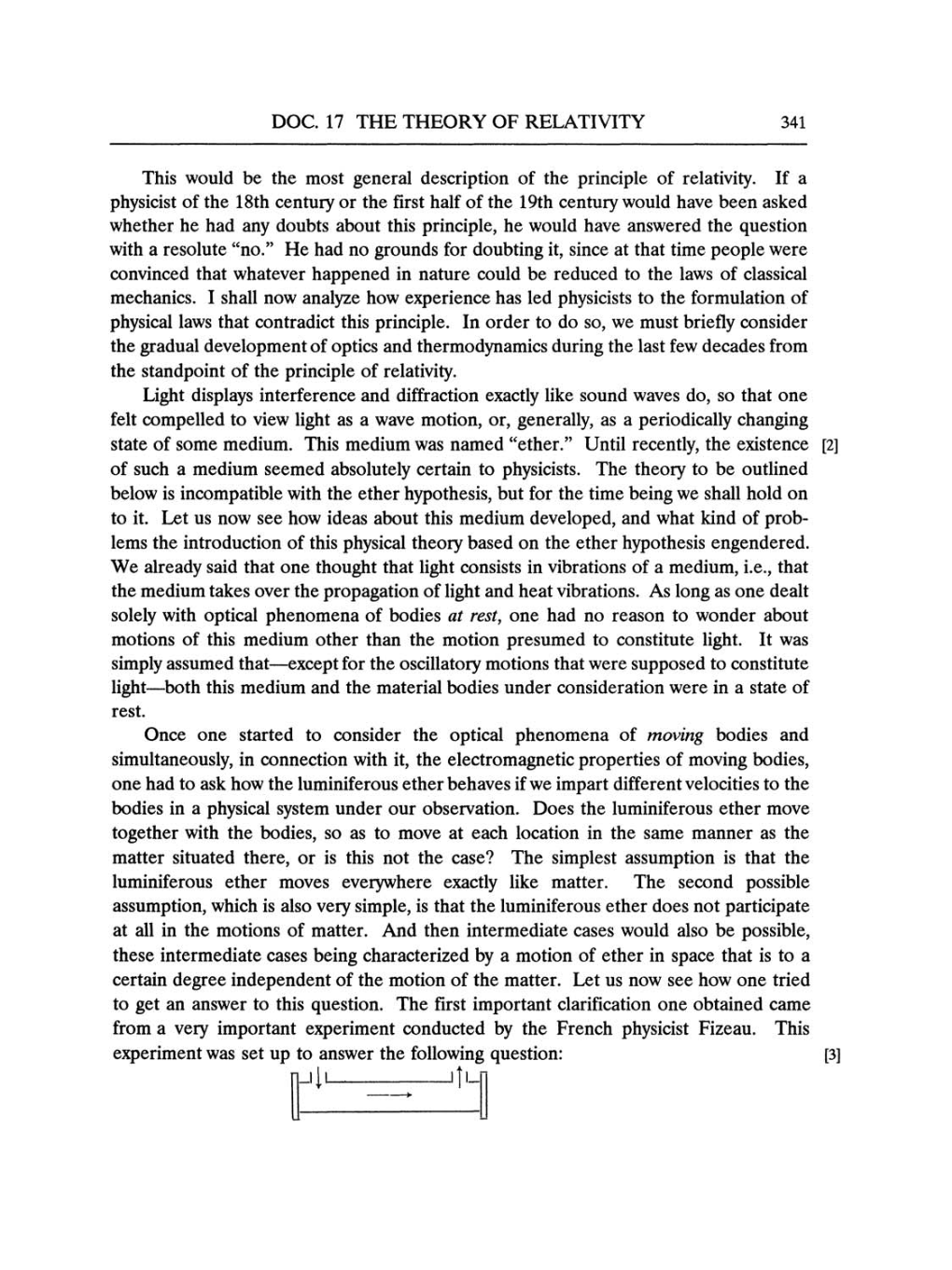DOC.
17
THE THEORY
OF RELATIVITY
341
This would be
the
most
general description
of the
principle
of
relativity.
If
a
physicist
of the
18th
century
or
the
first
half of the
19th
century
would have
been
asked
whether
he
had
any
doubts about
this
principle,
he
would have answered
the
question
with
a
resolute "no." He had
no
grounds
for
doubting it,
since at
that time
people
were
convinced
that
whatever
happened
in nature could
be reduced
to
the
laws
of
classical
mechanics. I shall
now analyze
how
experience
has led
physicists
to
the formulation of
physical
laws
that contradict
this
principle.
In order
to do
so, we
must
briefly
consider
the
gradual development
of
optics
and
thermodynamics during
the
last few
decades
from
the
standpoint
of the
principle
of
relativity.
Light displays
interference and
diffraction
exactly
like
sound
waves
do,
so
that
one
felt
compelled
to view
light
as a wave
motion,
or,
generally,
as a periodically changing
state
of
some
medium.
This
medium
was
named "ether." Until
recently,
the
existence
[2]
of
such
a
medium seemed
absolutely
certain
to
physicists.
The
theory
to
be outlined
below
is
incompatible
with
the ether
hypothesis,
but for the time
being we
shall
hold
on
to it.
Let
us now see
how ideas
about
this
medium
developed,
and what
kind of
prob-
lems
the introduction of
this
physical
theory
based
on
the ether
hypothesis
engendered.
We
already
said
that
one
thought
that
light
consists in
vibrations of
a
medium,
i.e.,
that
the medium takes
over
the
propagation
of
light
and heat
vibrations. As
long
as one
dealt
solely
with
optical phenomena
of bodies
at
rest, one
had
no
reason
to
wonder about
motions of
this
medium other than the motion
presumed
to
constitute
light.
It
was
simply
assumed
that-except
for
the
oscillatory
motions that
were supposed
to
constitute
light-both this
medium and the material bodies under consideration
were
in
a
state
of
rest.
Once
one
started
to
consider the
optical phenomena
of
moving
bodies and
simultaneously,
in
connection
with
it,
the
electromagnetic properties
of
moving bodies,
one
had
to ask how
the luminiferous ether
behaves if
we
impart
different
velocities to
the
bodies
in
a physical system
under
our
observation. Does the luminiferous ether
move
together
with
the
bodies, so as
to
move
at
each location
in
the
same manner as
the
matter
situated
there,
or
is
this not
the
case?
The
simplest
assumption
is
that the
luminiferous ether
moves
everywhere exactly
like matter.
The second
possible
assumption,
which
is
also
very simple,
is
that the luminiferous ether
does not
participate
at all in
the motions of
matter.
And then intermediate
cases
would also
be
possible,
these intermediate
cases
being
characterized
by a
motion of ether
in
space
that
is
to
a
certain
degree independent
of the motion of the
matter.
Let
us now see
how
one
tried
to
get an answer
to
this
question.
The
first
important
clarification
one
obtained
came
from
a very important experiment
conducted
by
the French
physicist
Fizeau.
This
experiment was
set
up
to
answer
the
following question:
[3]
